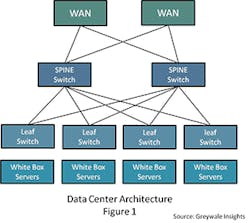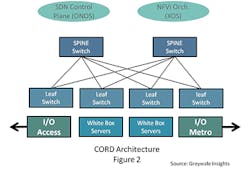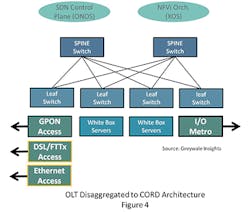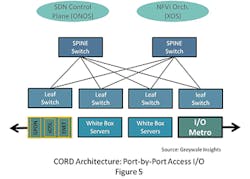Latest from C&E/NetDev Ops/GIS/Open-Source Networks
The access network company executives are facing once-in-a-career disruptions throughout their business. New technologies, new regulations, and new competitors make everyday decisions more complex. The competition comes from two dimensions. The first is competition for access, or the connectivity, from other facilities-based providers including the looming threat of municipal broadband. The second is competition for the more lucrative services from the cash-rich, fast-moving Web, Cloud, and Over-the-Top (OTT) providers. Adding to these challenges are the historical access network realities.
This access network, or Last Mile, is a challenging business. It has thousands of miles of facilities (wires) that radiate from central offices and cable hubs, and they terminate in nearly every home and building in the serving area. It has specialized outside plant electronics deployed in cabinets, in underground vaults, and mounted to utility poles. Adding to the challenges are onerous federal, state, and local regulations that hinder flexibility. Then you have real operational challenges including lightning strikes, floods, backhoe fades, and squirrel chews.
CORD stands for Central Office Re-architected as a Datacenter. The CORD community promises the "Economics of the Data Center" with the "Agility of the Cloud". OpenCORD, a LINUX Foundation Initiative, according to ON.Lab, is a vision, an architecture, and a reference implementation. It’s also "a concept car" according to Tom Anschutz of AT&T. What you see today is only the beginning of a fundamental evolution of the legacy telecommunication central office (CO) and subsequently the Outside Plant (OSP) and CPE too. With the move to more and more "up to" a gigabit access, a linear extension of today’s technologies and architectures is unsustainable.
CORD is the biggest innovation in the access network since the introduction of ADSL in the 1990s, and can truly change the economics of the central office. With the simplification of both deployment and ongoing operations combined, the CORD architecture can plausibly achieve a 75% reduction in OpEx.
CORD leverages years of innovation in the data center. The modern data center architecture is shown in Figure 1. The CORD architecture, show in Figure 2, utilizes the data center’s Leaf-Spine switch fabric. Connected to the leaf switches are "white box" servers. What’s unique in CORD are the I/O (Input/Output) shelves. The traditional data center has 2 redundant WAN ports connecting it to the rest of the world. In CORD there are 2 "sides" of I/O. One, shown on the right in Figure 2, is the Metro Transport (I/O Metro) connecting each Central Office to the regional or large city CO. On the left side of the figure is the access network (I/O Access).
An OLT is a chassis that has the power supplies, fans, and a backplane. The latter is the interconnect technology to send bits and bytes from one card or blade to another. The OLT includes 2 management blades (for 1+1 redundancy), 2 or more uplink blades (Metro I/O) and the rest of the slots filled up with line cards (Access I/O). In GPON the line cards have multiple GPON Access ports each supporting 32 or 64 homes. Thus, a single OLT with 1:32 splits can support upwards of 10,000 homes depending on port density (number of ports per blade multiplied by the number of blades multiplied by 32 homes per port).
Disaggregation maps the physical OLT to the CORD platform (See Figure 3). The backplane is replaced by the leaf-spine switch fabric. This fabric "interconnects" the disaggregated I/O blades. The management functions move to ONOS and XOS in the OpenCORD model. The new Metro I/O and Access I/O blades become an integral part of the innovated CORD architecture as they become the I/O shelves of the CORD platform.
This Access I/O blade is also referred to as the GPON OLT MAC, and can support 1,536 homes with a 1:32 split (48 ports times 32 homes/port). In addition to the 48 ports of access I/O they support 6 or more 40 Gbps Ethernet ports for connections to the leaf switches.
This is only the beginning of the CORD evolution, and by itself has a strong value proposition for the
service providers. Consider if a service provider has 1,600 subscribers to serve: they simply need to install a
1 U (Rack Unit) shelf. No longer do they have to install another large chassis traditional OLT that supports an additional 10,000 homes.
The access network is by definition a local network and localities vary greatly across regions and, in many cases, on a neighborhood-by-neighborhood basis. Thus, it’s common for an access network or broadband network operator to have multiple access network architectures. Most ILECs leveraged their twisted pair copper cables that connected practically every building in their operating area to offer some form of DSL service. Thus, at a minimum there are 2 separate infrastructures from the CPE, to OSP to CO. Add a second vendor for each, and you’re up to 4 completely separate systems. Each also has their own unique management systems, spares, Method & Procedures (M&P), et al.
To support DSL-based services in the CORD architecture one only has to develop a new I/O shelf. The rest of the system is the same. (See Figure 4.) Now, both GPON infrastructure and DSL/FTTx infrastructures "look" like a single system from a management perspective. The same service bundles (with obvious limits) can be offered to a service provider’s entire footprint.
Since CORD is a "concept car" — one can envision even finer granularity. Driven by Moore’s Law and vendor R&D investments, it’s plausible that each of the 48 ports on the I/O shelf could be defined by downloading software and connecting the specific Small Form-factor pluggable (SFP) optical transceiver. (See Figure 5.) If an SP wanted to upgrade a port servicing 32 homes from GPON to XGS PON (10 Gbps symmetrical) they could literally download new software and change the SFP and go. Then, ideally, they could ship a consumer self-installable CPE device and upgrade their services in minutes. No truck roll required!
Then reconnect/re-provision each home to the appropriate port in the CO. With CORD, you qualify the software, the SFP and CPE, the rest of your infrastructure and operations are the same!
This port-by-port granularity also benefits smaller COs and smaller SPs. In large metropolitan COs, a shelf-by-shelf partitioning (1 shelf for GPON, 1 shelf of xDSL, etc.) may be acceptable. However, for smaller COs and smaller SPs this port-by-port granularity will reduce both CapEx and OpEx by enabling them to grow capacity port-by-port to better match actual growing traffic demands.
CORD can’t solve backhoe fades or squirrel chews, yet it changes the economics of access. With the simplification of both deployment and ongoing operations, combined with the rest of the CORD architecture, the 75% reduction in OpEx is a viable goal for service providers of all sizes.











